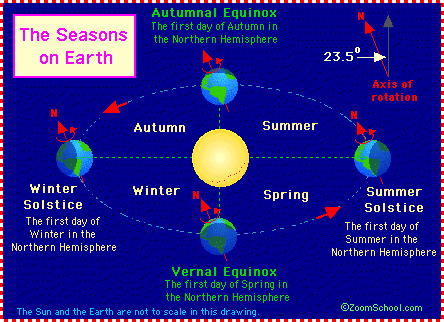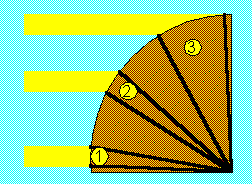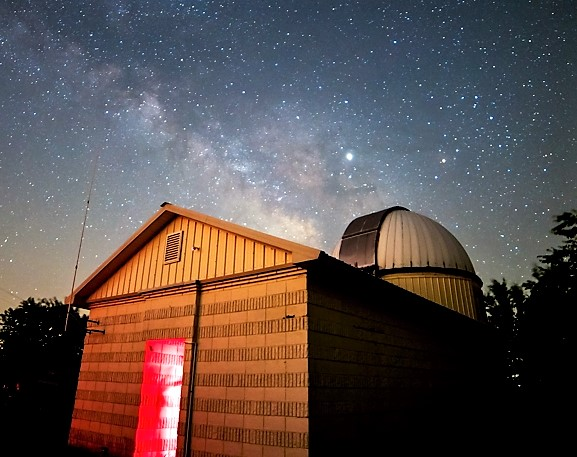The Seasons

In this lesson I will talk about what causes our four seasons, spring, summer, fall, and winter. I will cover this by telling some of the myths about what many think are the cause of our seasons and then some well known facts. There is a lab at the end of this lesson and it will help you understand why summer is so hot and winter is cold.
The earth orbits around the sun in 365 1/4 days making up one year on earth. At the same time the earth is tilted 23.5 degrees from its axis of rotation and this is the only reason we have our four seasons. One myth that has been around for decades is that we are closer to the sun on one side of the orbit than the other which causes our seasons. The earth's orbit works this way, but it has no effect on the seasons.
The average distance the Earth is from the Sun is 93 million miles. The difference between aphelion (farthest away from the Sun) and perihelion (closest to the Sun) is 3 million miles, so that perihelion is about 91.4 million miles from the Sun. Earth goes through the perihelion point a few days after New Year's Day, just when the Northern Hemisphere has winter. Aphelion is passed during the first days of July. This means the summer occurs in the United States when we are as far away as possible from the sun. This by itself shows that the distance from the sun has no effect on our seasons.
What is important is that when Earth passes through perihelion (closest to the sun), the northern end of Earth's axis happens to tilt away from the Sun, so that the areas beyond the Tropic of Cancer receive only slanting rays from a Sun low in the sky.
There are 5 major zones on the earth.
| Northern Frigid Zone runs from the north pole to the Arctic Circle | 90.0º to 66.5º |
| Northern Temperate Zone runs from the Arctic Circle to the Tropic of Cancer | 66.5º to 23.5º |
| Torrid Zone runs from Tropic of Cancer to the Tropic of Capricorn | 23.5º to -23.5º |
| Southern Temperate Zone runs from the Antarctic Circle to the Tropic of Capricorn | -66.5º to -23.5º |
| Southern Frigid Zone runs from the south pole to the Antarctic Circle | -66.5º to -90.0º |

As light travels through the atmosphere, some of the energy is absorbed. This is why the sun feels less intense in the winter than in the summer. Notice how light ray #1 doesn't travel very far through the atmosphere. This corresponds to the sun being "directly overhead." Ray #2 travels slightly farther through the atmosphere, and ray #3 farther still. Finally, ray #4 has travel through a great deal of atmosphere. Thus, it has much less energy left when it reaches the ground. This is part of the reason why the polar regions are colder than other parts of the earth.
Another factor that causes the climate to be colder for places farther from the equator is that a given amount of light (and heat) is spread over a larger area, so the energy is less concentrated. This is also why the highest temperatures on a given day are on or slightly after noon.

Notice how area #2 is slightly larger than area #1, and area #3 is much larger. The energy per square meter reaching the earth at a latitude of 60° is only half that of the energy reaching the earth at the equator.
Below is a summary of the four seasons seen from the United States
The Spring Equinox (around March 21st)
- The direct rays are at the equator
- Six months of daylight begins at the North Pole
- Six months of darkness begins at the South Pole
- Twelve hours of daylight and twelve hours of darkness all over the earth
- It is the longest day of the year on the equator
- The sun rises due east and sets due west
- Spring begins in the Northern Hemisphere
- Autumn begins in the Southern Hemisphere
The Summer Solstice: (around June 21st)
- The direct rays are as far north as they go; the Tropic of Cancer
- The North Pole is in the middle of a six-month period of light
- The South Pole is in the middle of a six-month period of darkness
- It is the longest day of the year in the Northern Hemisphere
- It is the shortest day of the year in the Southern Hemisphere
- It is the shortest day of the year on the equator
- The sun rises north of east and sets north of west
- Summer begins in the Northern Hemisphere
- Winter begins in the Southern Hemisphere
The Autumn Equinox (around September 23rd)
- The direct rays are at the equator
- Six months of darkness begins at the North Pole
- Six months of light begins at the South Pole
- Twelve hours of darkness and twelve hours of light all over the earth
- It is the longest day of the year on the equator, again
- The sun rises due east and sets due west
- Autumn begins in the Northern Hemisphere
- Spring begins in the Southern Hemisphere
The Winter Solstice: (around December 21st)
- The direct rays are as far south as they go; the Tropic of Capricorn
- The North Pole is in the middle of a six month period of darkness
- The South Pole is in the middle of a six month period of light
- It is the shortest day in the Northern Hemisphere
- It is the longest day in the Southern Hemisphere
- It is the shortest day of the year on the equator, again
- The sun rises south of east and sets south of west
- Winter begins in the Northern Hemisphere
- Summer begins in the Southern Hemisphere
So why is it so hot in July and August when the first day of summer is June 21st? Similarly, why is December 21st, the day of least sunshine, the beginning of winter when January and February are usually much colder? The answer is simple and there is only one thing to blame, the oceans.
The oceans, which heat up and cool down only slowly are the main cause. By June 21 they are still cool from the winter time, and that delays the peak heat by about a month and a half. Similarly, in December the water still holds warmth from the summer, and the coldest days are still on the average a month and a half ahead.
Lab Experiment
The idea for this lab came from a sixth grade student in Tulsa, Oklahoma. She did something similar for a science project.
In this lab you will get a better understanding why it is colder in the winter and warmer in the summer. This lab has two parts to it. Part one will take about one month as you observe the moon's position in the sky. Part two will take about a year to complete as you observe the sun once a month at noon. You may ask what the moon has to do with seasons, nothing. The sun, moon, and planets all follow the same path called the ecliptic. The ecliptic is the plane of the solar system where all the planets orbit the sun. Think of it as a cheese pizza and the planets are 9 meat balls. Now if you tilt one of the meat balls, the earth, 23.5 degrees, you have a model of our solar system. Since the moon travels the same path as the sun but in only one month, you can get the same effect as you would with the sun but in one month.
This lab assumes you live in the mid northern latitudes. If you live in the Southern Hemisphere, the same concept will work, but the sun will be low in the north during winter.
Part 1
This part of the lab will show you how the moon, sun, and planets move along the ecliptic. The sun at the southern end of the ecliptic during the winter and at the northern end in the summer. Since the moon follows the same path in only one month, you can see how the sun moves.
Find out when the next new moon will occur, this is the starting point.
For the next 7 days, you will be watching where the moon sets. You will need to find out where due west is located. During the first 2 days, you may not see the moon. Observe in the west the direction the moon is moving north or south. Each day the moon will continue to move in the same direction until it gets to the high or low part of the ecliptic.
During the next 10 days, you will see where the moon rises in the east. You may need to look up the moon rise time. A link to moon rise times is at the bottom of part one. Again, observe in the east how the moon moves. This is what the sun does over the year.
During the next 7 days, you will be observing where the moon sets in the west. Steps 2 and 3 are done in the evening. Step 4 will be done during the morning at the beginning and around 3pm by the end. Keep observing when the moon sets until you can't see the moon anymore.
What you want to observe is the direction the moon is moving either north or south. At two points it will change the direction it has been moving. These are the northern and southern points of the ecliptic. Make a note to see if the moon looks brighter when it is far north on the ecliptic compared to when it was low in the south. If you are wondering why sometimes you look in the west and other days you look in the east. I set up the lab this way so you would not be up in the early morning hours. The best time to do this lab is in June or December. During those months the full moon is low in the ecliptic in June and high in December.
Part 2
This part takes less of your time but takes a year to complete. The best time to start this part is on one of the four season days, June 21, Sept. 21, Dec. 21, or March 21. However, this part of the lab can be done anytime.
Once a month on a day you choose, go outside and see how high the sun is in the sky.
Be sure to go out between noon and 1pm. If you have bad weather, pick the next clear day.
Please do not stare at the sun, you only need to see where it is in the sky.
What I want you to observe is the temperature and how long your shadow is. Is it longer when the sun is low in the sky during winter. A longer shadow shows you the angle the light and energy is coming from the sun. The more of earth's atmosphere it has to go through, the cooler it gets. When the sun is high in the sky, do you even have a shadow?
Like the moon, the sun will move north or south each month until it reaches the high or low points of the ecliptic, then it will move the other direction.



